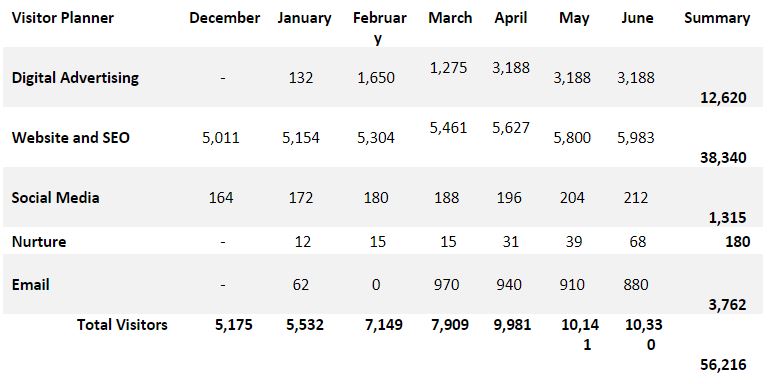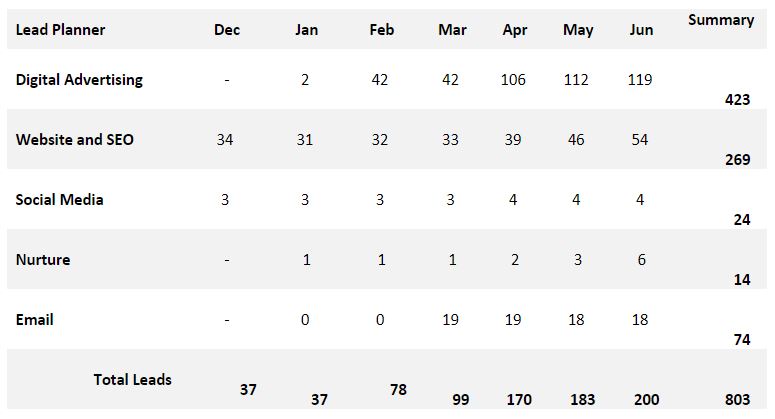Digital Marketing Planning Guide
In order to create a strong digital marketing plan you need to tie your marketing investments to the organization’s business goals to create a Return on Investment, or ROI. Most marketers can quickly calculate the investment part of the equation in terms of media or creative costs, but they have a hard time understanding the return. I’ve often heard marketers talk about the ROI in terms of clicks, social media mentions, press mentions, retweets, conversions, or some other marketing metric. While many of these metrics are important, they are not a return. A “return” is measured in money—period. If you can’t calculate the return in terms of money, there is no ROI.
To calculate a true ROI, you need to connect the dots between the investment you make and the dollars you generate. This can be more or less difficult depending on your industry. If you are a B2B marketer, your marketing investments will generate leads, and you’ll need to track these leads all the way through the sales process in order to determine which source of leads is most effective. For example, if you invest $10,000 in a campaign and you generate 100 leads, your cost/lead is $100.If your sales team closes 10 of these leads, you get 10 new customers, and you can measure the sales and profits from these transactions to help you calculate the ROI.
Once you have this level of tracking in place, you can calculate the ROI based on the money you make from each sale. If you make $1,000 from each sale, your ROI is 0%—you broke even. If you make $5,000 from each sale, your ROI is 400%.If you make $50,000 from each sale, your ROI is 4,000%.
The beauty of digital marketing is that you can track this at a much more detailed level than you can with traditional marketing. You can see which offers, keywords, campaigns, or messages produced these leads and sales, and spend more on those parts of your campaign. You can also cut your budget on campaign elements that do not produce results. By doing this you will not only be able to calculate the ROI, but improve the ROI over time by basing the return in the equation on real money.
In each area of your Internet marketing mix, there are many intermediate measures that you can use to tell if you are on the right track. Don’t be confused. The only real measure of success that counts for most companies is producing more money for the organization.
Marketing Planning
Marketing’s role in demand generation is not a support function but a core business function, just like sales, manufacturing, and distribution. It is marketing’s responsibility to drive the leads, traffic, and website visits that are necessary for the company to be successful.
Marketing’s demand generation work can be put on a quota in a way that is completely integrated with sales. If the sales team is responsible for creating 1,000 proposals over the course of the year, then marketing may be responsible for generating 10,000 leads to enable this sales activity. All of the core demand generation activities can be tracked and measured to make sure that marketing is fulfilling its core demand generation role to support the business.
High-performance marketing requires a very different mindset than the strategic, creative, public relations or brand thinking that many people associate with marketing. It requires a focus on campaigns with goals, budgets, and metrics that track results. It also requires planning that is linked directly to sales planning.
Developing Marketing Plans
In order to be successful with your demand generation program, you need to create a marketing plan that is driven by results, not activity. How can you tell the difference? An activity-based marketing plan will describe what the marketing team will do, not what it will achieve. An activity-driven plan might include the following items in given month:
- Weekly email campaign to prospects
- Monthly e-newsletter to customers
- $10,000 ad spending
- Two press releases
- 50 posts on social media sites
- New white paper content on the website
A results-driven plan might include the same items, but include goals and costs:

To calculate some of these investments, you’ll need to track the marketing team’s time to determine what it costs to produce items that require a time investment, such as social media or new content. Once you finish the month, you’ll be able to add actual results and calculate your cost per lead, and cost per customer. Then you’ll be able to adjust the plan, focusing on the items that made the most impact for the lowest cost.
Just as the sales team has a quota for the revenue they are accountable for each month, the marketing team also needs to be held accountable for driving demand. This demand can be measured and evaluated in order to help the business leaders make good decisions on moving the business forward.
The first step in building your plan is to benchmark each of your marketing actives to see where you stand. These metrics might include:
Website—For each source:
- Total visitors
- Organic search visibility and traffic
- Leads or sales
Digital Advertising—For each channel:
- Impressions
- Clicks
- Conversions—leads and sales
Email—For each target audience:
- House email list size
- Potential list size that you could purchase
- Click-through rate and conversion rate on emails sent
Social Media—For each social media site:
- Followers
- Clicks to the website
- Leads and sales
Once you have a good understanding of your metrics and how your activity turns into results, you’re ready to build your annual marketing plan.
The goal of the plan is to leverage the top performing marketing channels to generate the most qualified leads and sales for each marketing dollar invested. To reach this goal, you will build a marketing campaign plan that demonstrates, month by month, how your marketing, lead generation, and sales objectives will be achieved. The plan will consider the performance of various activities that could be used to achieve the objectives of the campaign, including digital advertising, SEO, email marketing, social media marketing, website optimization, and email lead nurture. You’ll also need to review existing content assets to identify gaps and create a plan for future content production.
When you have the data ready, the plan should look something like this: The plan starts in January with real data from all of your programs, and then predicts improvements based on the actions you’ll take during the year. These actions might be building a new website to improve conversion rates, investing in SEO, buying a bigger email list, creating better content, or spending more money on advertising. All of these activities should tie directly to improvements in your plan and produce a positive ROI.


One you have the plan ready, you can use it as a living, breathing tool throughout the year to record your actual results so that you can learn whether or not your actions are working as planned.
Campaign Budget Decision Framework
One of the things you’ll notice when you build your plan is that not all programs generate results evenly. Some marketing tools are significantly more effective than others. When clients want to know the most important things they can do to improve their lead generation program results, I tell them to do the ones that are most effective first, and keep doing them until they can’t produce anymore. Then add activities to the marketing mix, in order from the best to the worst performers until the leads become too expensive to justify an ROI.
To do this, you need to start by getting common metrics on all of your marketing activities, such as the cost per lead or the cost per qualified lead and the number of leads or sales produced. Then sort the activities from best to worst. When we do this exercise for clients, we typically find that their website is the top performer, followed by organic search, paid search, and in-house email list programs.
Of course, you need to execute these programs well in order to get good results. You also can’t ignore up-and-coming marketing techniques, such as mobile or social advertising. It’s critical to build testing into your budget to find new techniques that can turn question marks into stars.
Back in the early 1970s, the Boston Consulting Group developed a concept for helping clients determine which product lines a company should put its resources behind. Markets were identified as high growth or low growth, and products were classified by whether they used cash or generated cash. “Stars” were promoted, “dogs” were divested, “cash cows” were harvested to support other initiatives, and “problem children” were monitored carefully in the hope that they would become “stars.” But obviously the risk remained that they would turn out to be dogs.
You can use this same approach to manage your portfolio of marketing programs. Build a 2X2 matrix with cost/lead or sales on the horizontal axis and leads or sales results on the vertical axis.
When you get your programs organized this way, you’ll quickly realize where you’ll need to focus your efforts. First, invest in the stars to see if these can pull in all of the leads or sales you need. Second, work on the cows. If you can find a way to get these low-cost techniques to build volume, you can turn them into stars. Next, focus on your problem children. These might be high producers that are expensive, but if you can bring the cost/lead down they can also turn into stars. Finally, think hard about the dogs. Do you really need them in your mix?
